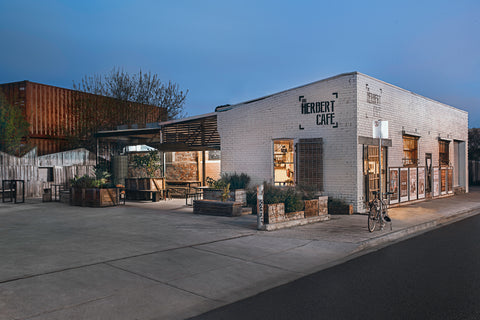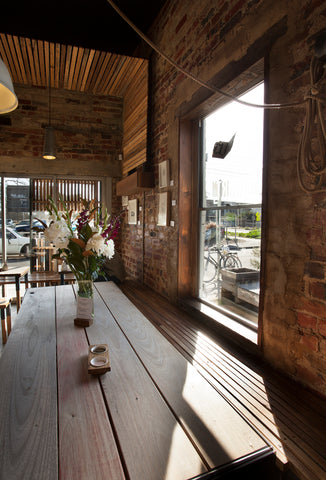For those of you that follow us on Instagram you would have noticed that back in July we installed (what we like to call) an outpost at The Herbert. We originally found the cafe after stumbling off the train one morning at the Northcote station.
Nestled on the far side of a large block that straddles the corner of Herbert Street and Arthurton Road one of The Herbert's distinctive characteristics is immediately obvious; a huge carpark. I can't think of many other cafes with a dedicated carpark. Given that Arthurton Road is a very busy thoroughfare this feature makes the cafe easily accessible.

Outside, the block is partitioned from the neighbours yard by a fence built from recycled wood shaped like the silhouette of factory roofs. Bordering the fence line and the entry to the cafe is a range of raised garden beds and seating areas. The garden beds hold both decorative and productive plants, forming a green buffer around the cafe perimeter also supplying the cafe with herbs and other fresh edible plants.
Inside (what was once a cabinet makers workshop) the building now houses the cafe, architects office and carpenters workshop, forming a micro community on-site. Like the outside, the interior of The Herbert cafe features the use of recycled timber, combined with repurposed industrial materials and new bespoke furniture, creating an informal, relaxed hangout.

The Cafe serves a considered menu of dishes backed up with coffee from Brunswick's finest roasters, Padre Coffee .
Behind superior projects like The Herbert Partnership there are special people, this story is an excuse for us to talk to Sophie Gandar, the brains and the brawn behind the cafe.

The Boroughs - We understand, that you have a background in writing, could you give us some insight into your work in that area?
Sophie - I was rotund and nerdy in primary school. I loved writing, and excelled in creative writing until going wayward as a teenager. My mum encouraged me by fabricating a ‘writing fairy’, who I’d submit stories to, and in the dead of night the fairy would come and appraise my work in infinitesimal handwriting, and leave small ceramics as recompense. I should thank her for this – it is truly amazing.
When I left New Zealand to live abroad, I found freelance work including creating copy for an artisan food directory. I helped friends with submissions, press releases and music biographies, and wrote for a few digital publications that shall remain secret.
B - How, if at all, does your previous professional experience influence what you are doing at The Herbert?
S - I don’t know if it does. I’ve always preferred ghost-writing or aliases, and I struggle to promote my own work. Some people are really good at selling themselves; I find it difficult to write earnestly, and a warped sense of humour and self-deprecating cynicism overshadow what would be a nice social media post. I prefer to have someone else handle Instagram – it’s more light-hearted.
I know how to get things done, and I think my previous work means I’m just as capable front of house as I am in administration and accounting. I’m extremely impatient, and want everything done immediately. I’m known to respond to emails instantly, as though it were a verbal conversation. I’m learning not to check work email after hours.
B - What inspired the move into food and hospitality?
S - I’d been working in documentation and infrastructural software until 2011, and in my second year living in London, I picked up some work at my housemates café on Portobello Road. I then took a full-time job at a small café in Hackney – both roles comprised front of house cooking and I realised I was okay at it? I’ve always enjoyed making food for people, and it was a lightbulb moment that that’s what I should do for a living.
My first year in London I worked on the Olympic 2012 build – I may have overstimulated myself and suffered a couple of seizure-type episodes. Working under fluorescent lights and staring at monitors all day wasn’t feasible anymore and while running a café can be extreme pressurised, it is the best most rewarding thing.

B -The Herbert is curious little enclave, there are architects, a cabinet maker and cafe on site, this is hardly the typical high street cafe. Were you attracted to this community set up?
S - My business partners are an architect and builder. They’d been working together on myriad projects and three years ago really needed a space to make frequent meetings easier. The building was a cabinetmaker’s commercial residence in a past life, but it’s been sectioned off to house the café, an architectural studio, and a workshop – where the café furniture is built/repaired and all manner of bespoke things are built. There’s a gentle air of self-sustainability on site, but we don’t run around nude after hours.
I was definitely attracted to the workshop – I stripped and rebuilt a vintage Apollo II road bike (okay, with a little help) – and I’m nuts for sanding. I’ll sand anything. Most of the furniture in my house is sanded and oiled. I dunno. Sanding steel is cool too. Oh, sanding.
B - How did you get involved?
S - I used to cycle past at dawn and wonder what the hell it was. There was no signage back then – just a graffiti slathered building and a giant carpark. I’d been looking for a management opportunity after landing in Melbourne and wandered in one day. James (the builder) was cashing up indignantly and gave me the third degree about whether I’d be able to cash up. I thought he was a jerk, but I assured him I was capable, started the next week and set about turning it into a well-functioning but relaxing space to eat and drink. The coffee was always wonderful – Padre are killer roasters, and St David’s in Fitzroy bottle the best boutique milk in all the land.
I bought out a third original partner at the end of 2014 and have cried myself to sleep every night since.
Just kidding. Not every night. And I’m very proud of the café.
B - Describe the interior aesthetic for us?
S - I guess it’s industrial? But warm. It’s literally a bang-up job – most of the materials were sourced through inorganic scouring, and all the timber on the walls and tables are leftovers from building sites. I concede this makes my partners very clever – people always comment on the aesthetic, the light fittings and features. James and Tobias have done a superb job with space-management and acoustics.
The concrete bench was set in the workshop, and Tobias is a raving lunatic for building steel-framed furniture.
We take great care to provide a visually appealing environment and I’d hope people considered the space inviting, a bit design-y, but uncontrived.

B -Your menu at The Herbert is concise, tell us about your approach/direction to food in the cafe context?
S - The approach is very much dictated by the space. Our wee tiny long-suffering grill cooks every single meal and has only been ill once. We can’t do poached eggs in the 1 square metre bench space, so instead we focus on using seasonal produce, high-end gluten free breads, and free-range meats and dairy, to make meals that are fresh and simple and not-overworked. We season well. The menu is short but with specials, I think it caters for the varying degrees of hunger and preference and weather.
I can’t even remember designing the menu – there was so much to do at the time. Some people eat our roast vegetable sandwich or avocado chickpea smash every day. Changing the menu gives me intense extra-workload fear, but I also couldn’t rob those people of their daily rituals.
Salads are cool – they’re probably where I get to be most inventive.
I think spending a little more on organic, artisan products pays dividends down the line – they’re nicer to work with and it’s really evident on the plate.
B- Are you trying to cater to a specific dietary requirement or philosophy?
If your kitchen was larger, would this influence your menu?
S - Everything we serve is easily adapted to the dietary nuances of 21st century man.
If the kitchen were larger it would totally influence my menu! I’d experiment much more and maybe one day create The Perfect Meal as voted by readers of The Guinness Book of World Records.
B - We love your garden - tell us about what the garden means to you. It looks like a mixture of productive and decorative plantings, did you set out to supply the cafe with a kitchen garden? Do have plans for how the garden might evolve?
S - I love it too. Watering a garden is a great stress relief. It should in theory grow things we can use in the kitchen – but it is also a giant basket of toys for small hands. As such, it’s best not to rely on anything growing long enough to be more than decorative. I propagate a lot, and love growing culinary plants, but the aesthetic is more important to me at the end of the day, and I don’t like harvesting to a bare patch.
We do use the herbs, and the lavender makes a beautiful tea. I eat all the strawberries before anyone gets a look in.
A couple of times I’ve arrived at work to find the garden’s been vandalised – so I’m not making any grand plans except to establish the new natives, and find something that will grow up our steel lattice to hide the water tank. Passionfruit?
B - Community is important to the Boroughs, sharing, working together with the people and businesses around us, is this a philosophy that you also embrace?
S - Of course. I think boosting your professional cohorts and listening to people and building relationships with other companies that care less about the dollar and more about the moment makes a very smart businessperson in 2015. Is that idiosyncratic?
I don’t know. I’m proud of all the people I know in small business and like friends, I’d want the best for them. If you can help a brother out, why wouldn’t you?
Don't take our word for it folks; pop along to The Herbert, you'll eat and drink well and have the opportunity to pick up a selection of Boroughs products too.

